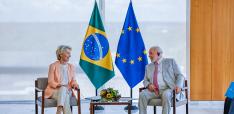BRICS and non-alignment today

Branko Milanovic argues that the BRICS countries' increasing independence and clout may be a net good for pressing global problems.
The expansion of BRICS membership is directly related to the expansion of NATO and NATO-like alliances around the world. When this statement is read superficially without understanding what is meant it seems wrong: the two organizations could not be more dissimilar. The new globalized NATO is a hierarchical, monolithic, and military alliance. None of the four terms applies to BRICS. BRICS is non-hierarchical; the members are extremely heterogeneous and often in political disagreement with each other; BRICS’ objectives are not military; and it is not an alliance but a mere organization. While two of the now eleven BRICS members are in open or tacit conflict with the West, the others are not. BRICS is not a counterweight to the West or NATO. But it is growing in reaction to NATO’s globalization. Why? Because it is the only place where nations not interested in participating in the new Cold War, or even in a possible hot war between the superpowers, can “run away” in order not to have to choose sides.
It is a profound misunderstanding of what BRICS is, to search for commonalities amongst the members and not having found them to dismiss the organization. Looking for commonalities at times makes sense—but not always. Let’s go over some historical precedents. We can think of international political organizations in positive terms, that is of countries banding together because they believe in a set of common things (which they might consider values). When the Nazis created the Anti-Comintern Pact (the Tripartite pact), the member-countries, spanning two continents, believed in nationalism and fighting Communism; when NATO was formed in 1949, the member countries believed in democracy and containment of the Soviet Union; when the Warsaw Pact was formed in 1955, the member countries believed in expansion of communism, or at least in defending it over the area it then ruled.
But when the non-alignment movement was formed in the late 1950s and early 1960s (note the dates!), or later the Group 77, the members did not possess a positive agenda similar to the ones I just listed. Their agenda was negative: they did not want to have to choose sides in the Cold War waged between the West and the East. They wanted to stay out of it. Many people failed to understand the logic of non-alignment, precisely because they failed to understand that you can create an organization composed of heterogeneous countries that may disagree on many issues, but find it useful, for geopolitical reasons, to get together in a loose association. Non-alignment was liked neither by the Soviet Union nor by the USA. The Soviets believed that it was superfluous because the USSR was “the natural ally” of the Third World and decolonization and rather than getting together in a new organization, the Third World countries should simply support the Soviet bloc. The United States saw the non-alignment as little better than betrayal: countries who drew the equivalence between democracy and tyranny. John Lewis Gadis, the US historian of the Cold War, barely disguises his contempt for the movement and when he condescends to note it, calls it “the so-called ‘non-alignment’ movement.”
The movement in fact ended with the end of the Cold War. This also shows what its true role was: to be a buffer zone during the global confrontation between the US and the Soviet Union, and to minimize the likelihood of their members becoming the ground on which the proxy wars may be fought. Once that confrontation ended, there was no room for non-alignment. It was not obvious what one is non-aligning with anymore.
But now when the contours of a new Cold War are apparent, the need for an organization grouping countries that do not want to be involved in it (and including, somewhat incongruously, and for historical reasons, countries that are in war or conflict with NATO and the West, namely Russia and China) has naturally re-emerged. Many commentators dismiss the new BRICS because they dislike the idea of the formerly Third World nations, whose economic importance has risen, getting together. They fear the grouping will, in some economic areas like de-dollarization or international infrastructure finance, challenge Western supremacy. Others, as I mentioned, very wrongly believe that any grouping must be based on some shared ideas, values, interests, or on hegemonic pressure. Not finding any of the four among BRICS, they dismiss them. Indeed, if BRICS could have more in common they would be stronger. But they do not, and cannot have - for various historical, political or cultural reasons. Yet, the fact that an increasing number of countries want to join BRICS cannot be ignored, nor taken lightly. BRICS’ refusing to participate in new global trade, proxy or actual wars may make such wars less likely. And BRICS’ economic clout may help reduce some of the glaring economic imbalances between the rich, middle-income, and poor nations across the world.
Photo by fauxels


